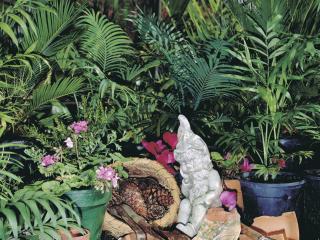Although gardens occasionally experience waves of seasonal pests, most common pests and diseases originate from within our gardens, and damage can be minimised if we understand the basics of their biology and the local ecology.
Within our fences there is usually a stable ecosystem in which plants, animals and pathogens coexist in a state of balance. As gardeners, we manipulate this ecosystem by supplying water and nutrients but, most of the time, our garden needs little looking after. It is important to keep this concept in mind when we disturb this balance by using pesticides or introducing a new plant, pet or pond.
Thoughtful garden design
When improving the soil buy products from a reputable source so amendments are disease and weed free and organic material and manure composted.
Thoughtful design allows for optimum interaction between man-made structures, plants and animals. Basic but important considerations include correct orientation so that the structures, trees and other large plants provide shelter from strong winds, create shade in summer, and let in winter sun. Creating zones for plants with similar requirements can minimise pest and disease problems and reduce watering.
Any style of garden will eventually progress towards a balanced ecosystem.
Soil health
A healthy soil contains many beneficial organisms (like earthworms, insects, nematodes, fungi and bacteria) and pathogens (some nematodes, fungi and bacteria). Organic matter, such as moist leaf litter or compost, provides the energy for soil microbes. Natural microbial activity in the soil breaks down organic material and releases nutrients to the plants.
Numbers of many soil pests are kept low by the action of these beneficial organisms. On very sandy coastal soil the addition of clay (from 0.5 to 2kg per sqm) worked into the top 30cm will improve soil properties and, together with added compost, will improve the soil’s capacity to retain water and supply nutrients to the plants.
The home gardener can convert home and garden waste to good soil by building a compost heap. Establishing worm farms is another method of obtaining good compost.
As a rule healthy soil and plants which are well watered and fertilised create healthy plants which are less susceptible to pests and diseases.

